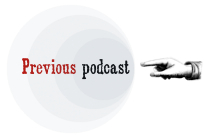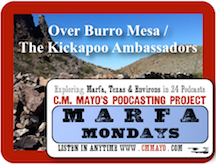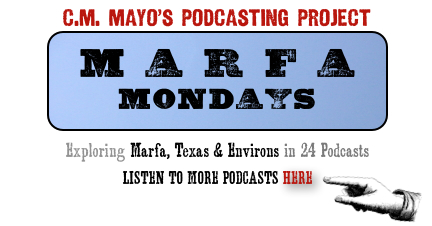|
Author of The Last Prince of the Mexican Empire, etc. |
|
|

|

|

|
|
OVER BURRO MESA AND THE KICKAPOO AMBASSADORS |
|||
 |
|||
|
(APPROX 16 MINUTES) |
|||
|
|
|||
|
|||
|
For those of you listening in for the first time, an especially warm welcome. You can find all the podcasts, which you can listen to anytime, on my website cmmayo.com. Previous podcasts include an interview with Mary Bones about the Big Bend's "Lost Art Colony"; an interview with Paul Graybeal, owner of Marfa's Moonlight Gemstones; "A Visit to Chinati Hot Springs"; "We Have Seen the Lights" about the strange phenomena of the Marfa Lights; "Artist Mary Baxter, Painting the Big Bend"; and last up, podcast number 13, my interview with historian John Tutino, who offers a take on Mexcan history back when Mexico included what is today Far West Texas, that will knock your huaraches off. And we talked a bit about "Giant," the movie filmed in Marfa, as well. Those of you who have been following the podcast series will note that it's been a bit slow this year. The reason is I went and wrote a different book— though it does have quite a bit to do with this U.S.-Mexico border region. The title of that book is Metaphysical Odyssey into the Mexican Revolution: Francisco I. Madero and His Secret Book, Spiritist Manual. Francisco I. Madero, the leader of Mexico's 1910 Revolution and President of Mexico from 1911 to 1913, was a Spiritist medium. He wrote a Spiritist how-to book and I translated it and gave it an introduction, which I hope will be interesting for the general reader, and those already well-versed in metaphysics, but most especially, anyone interested in Mexican history. That book is now available in paperback and Kindle, and in Spanish: Odisea metafísica hacia la Revolución Mexicana. Check it out and read excerpts on my website, cmmayo.com But back to Far West Texas. This podcast is a double podcast. First, a piece about my own journey over Burro Mesa into Apache Canyon the Big Bend National Park; and second, a most exotic bit of reporting about the visit of the Kickapoo ambassadors to the Emperor of Mexico, by his German gardener. Originally for this podcast I had thought to do an extended story about the Apaches. But the long, bloody story of the conquest of what had been the far north of New Spain and became Far West Texas is not for the squeamish. There were outrages on all sides. I know that many of you listen to these podcasts as you're driving or relaxing or coooking, so no worries, such difficult material— and it really is disturbing— will go into my book, but not the podcasts.
OVER BURRO MESA I had
ghosts on my mind—not in a spooky way, just stray thoughts
about long-gone people on a bright, hot morning in the Big
Bend National Park. In the foothills of the Chisos, I parked
on the road-side. My aim was to hike over Burro Mesa west into
Apache Canyon, to a corral where Apaches stashed stolen horses,
and to explore an arrow quarry. Now for the Kickapoo ambassadors to the Maximilian, the Emperor of Mexico, in 1865. The Kickapoo ambassadors actually came to Mexico City from Coahuila in the north [of Mexico], below the Texas border. The Kickapoos roamed over a vast region, including what is today Far West Texas. There is a splendid and very strange painting by French artist Jean Adolphe Beaucé which shows the ambassadors in feathers and faces painted red as Maximilian, in his top coat and splendid red beard, and Carlota, wearing gray gloves, receive them. On the back wall loom the portraits of Louis Napoleon and Eugenie, Emperor and Empress of France, whose army had conquered Mexico for this monarchy. I have written about
Maximilian and Carlota in two works, my novel, The
Last Prince of the Mexican Empire, and a long essay,
"From Mexico
to Miramar or, Across the Lake of Oblivion," what I
call a nonfiction novela about a fairytale, a visit to the Emperor
of Mexico's castle in Italy. All of which is to say, I'm pretty
familiar with the history of Maximilian and Mexico's so-called
French Intervention or Second Empire of the 1860s, which roughly—
very roughly—corresponded to the period of the U.S. Civil
War. So I was surprised and delighted to come across something
entirely new to me, which was Susanne
Igler's translation from the German into the Spanish, with Mexican
historian Amparo Gómez Tepexicuapán's introduction
to the memoirs of Maximilian's gardener, the botanist Wilhelm
Knechtel. "The Kickapoo were five men and four women, one of them with a child. They were wrapped in red and blue serapes, fantastic head ornaments of feathers, leather, ribbons and glass, and they walked with solemnity through Chapultepec Park, the women with their heads bare. The chief was an old man. From his neck hung a symbol of his authority: a great silver medallion with an engraving of a jaguar and a commemorative coin of Louis XV of France... They brought with them three black men from Texas as their translators. These people spoke the Kickapoo language, but no Spanish nor French, only English, a language which the emperor and empress spoke perfectly. The emperor received them very kindly and then had them served a meal in the park, at the entrance to the grand boulevard; the plates were put directly on the ground. In a circle, the Kickapoos knelt down and ate with their hands." If you want to look for that book by Wilhem Knechtel, the title [in Spanish is] Las memorias del jardinero de Maximiliano. [Note: Alas, it's very difficult to find a copy, but you might find one in a library via worldcat.org or available from a dealer on the used and rare book site www.interlibro.com] One more text to mention— but I won't read it for this podcast, it's much too gruesome— is the memoir of the Abbé Domenech, a French missionary who traveled through Far West before going down to Mexico City to serve Maximilian. You can find the English translation of his book, Missionary Adventures in Texas and Mexico: A Personal Narrative of Six Years Sojourn in those Regions on archive.org [MUSIC] Next up on the Marfa Mondays podcast is my interview with rock art expert Greg Williams, and then, after that, my interview with photographer Paul Chaplo about his magnificent new book, Marfa Flights. If you're anywhere in the area, don't miss the show of his photographs at the Museum of the Big Bend at Sul Ross [State University] in Alpine, Texas "Marfa Flights: Aerial Views of Big Bend Country." Check that out at MuseumoftheBigBend.com They will be on view until January 18, 2015. Thanks for listening. I invite you to listen in to the other Marfa Mondays podcasts anytime and also learn about my several books at cmmayo.com If you'd like to be alerted when the next podcast is liv,e you can subscribe to the RSS feed on my webpage, but better yet, subscribe to my free newsletter. The signup is right there on the webpage www.cmmayo.com Until next time. |
|||
|
|
|||
|
|||

|

